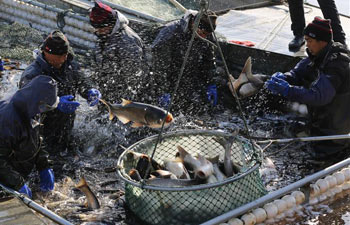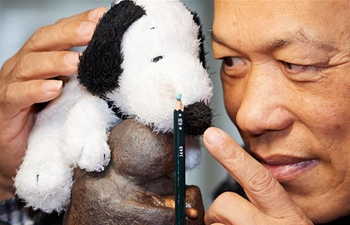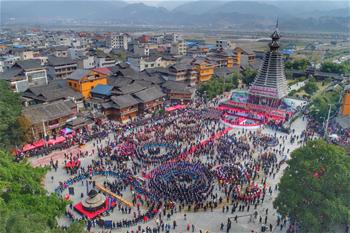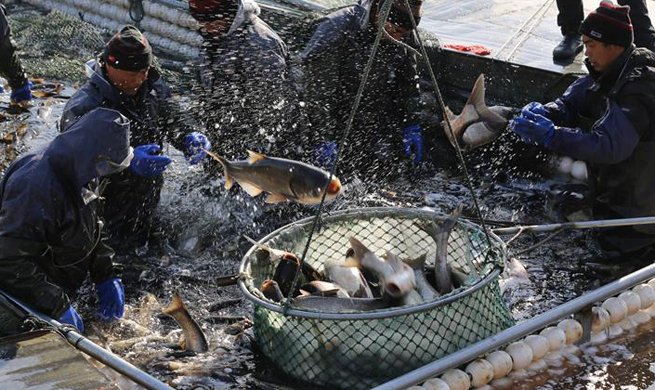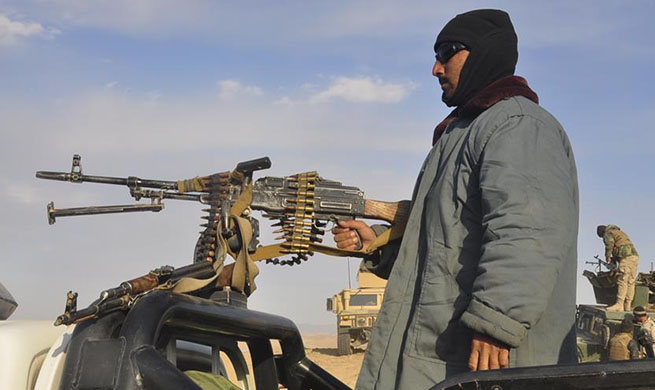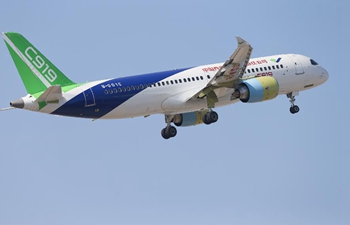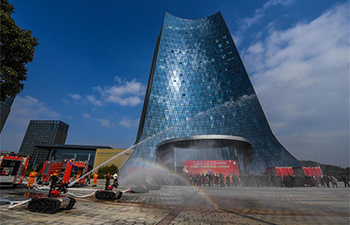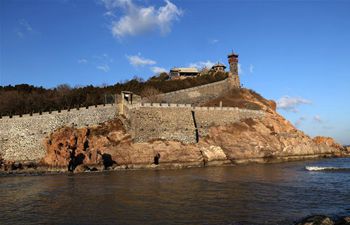by Abdul Haleem
KABUL, Dec. 19 (Xinhua) -- Just like in the past years, security problems have topped the challenges facing the government throughout this year in militancy-plagued Afghanistan, where thousands of U.S. and NATO-led forces have been fighting to win the so-called war on terror.
To win the longest and costliest battle in U.S. history, inherited from his predecessors George W. Bush and Barack Obama, U.S. President Donald Trump unveiled a new strategy in August for the war in Afghanistan.
In the controversial strategy, that also covers South Asia, Trump, besides stressing that more pressure be exerted on the Taliban and like-minded groups fighting in Afghanistan, also vowed to mount pressure on countries supporting the ongoing insurgency in the central Asian state.
Trump, while rejecting any plans to withdraw U.S. forces from the insurgency-plagued country in the near future, said that "our new strategy is a shift from a time-based approach to one based on conditions."
"America will continue its support for the Afghan government and the Afghan military as long as they confront the Taliban in the field," Trump said, with regards to the new strategy outlined on Aug. 21.
In the new strategy on Afghanistan and South Asia, the U.S. president also pointed finger at Afghanistan's immediate neighbor, Pakistan, as being a sanctuary for insurgents, and warned, "We can no longer be silent about Pakistan's safe havens for terrorist organizations, the Taliban, and other groups that pose a threat to the region and beyond."
The new U.S. strategy that has advocated for an increase in troops fighting militancy in Afghanistan has been welcomed by the Afghan government amid criticism by opposition circles, that believe the new approach will intensify the war in the already conflict-battered country.
INCREASING TROOPS
After Trump announced the new strategy on Afghanistan, Pentagon Chief James Mattis said that he would send more troops to the field.
Although Trump said in the new strategy that the number of troops deployed to Afghanistan would remain a secret, media reports have suggested that number of U.S. troops has increased from 11,000 in the past to 15,000 after unveiling the new strategy, to help bolster Afghan forces' power in the so-called war on terror.
The U.S. also called upon its allies to follow in its steps and send more troops to Afghanistan.
Complying with the demand, NATO member states and allied nations have pledged to send additional troops to the militancy-plagued country to help the embattled Afghan forces stabilize their country.
This is the first time since the drawdown of the U.S.-led coalition forces from Afghanistan in 2014 and the handing over of security responsibilities to Afghan forces by early 2015.
The U.S. air campaign in Afghanistan this year has also been increased since Trump assumed office and U.S.-led coalition forces' aircraft, according to media accounts, dropped more than 1,630 bombs compared to 545 reported cases of bombings in 2016.
The U.S.-led coalition forces' airstrikes have further intensified since the unveiling of Trump's new strategy and the forces, in addition to using drone strikes, have also used F-22 jet fighters and B-52 bombers, according to media reports.
The intensified air campaign in November targeted what the U.S. described as the funding network of Taliban militants in Bahramcha, Musa Qala and adjoining areas in the restive, poppy-growing Helmand province, along the border with Pakistan. The campaign reportedly killed scores of militants and allegedly destroyed more than two dozen heroin labs.
Taliban militants rebuffed the allegations saying the armed outfit does not operate heroin labs and all those killed in the air strikes were civilians.
The U.S. commander of the NATO-led Resolute Support (RS) mission in Afghanistan, General John Nicholson, however, confirmed the airstrikes on the heroin labs, stating: "The strikes are just the beginning, and it represents the U.S. and global will to defeat terror and the criminals who support terrorists."
Confirming the increase in airstrikes, a senior Afghan army commander in the southern region, General Wali Mohammad Ahmadzai, said recently that Afghan and foreign forces had conducted more than 400 air raids in Helmand province alone over the past eight months, in a bid to defeat the militants.
The surge in airstrikes, however, has raised the concerns of Human Rights Watch (HRW) over the possible increase in civilian casualties, with a senior Afghan-Based HRW researcher, Patricia Gossman, underscoring such concerns.
REGIONAL REACTIONS
While the Afghan government has welcomed the new U.S. strategy on Afghanistan and South Asia, critics at home, Afghanistan's immediate neighbors and regional powers have cast aspersion on the move.
Many Afghans, including former President Hamid Karzai, have referred to the strategy as warmongering, saying the new policy would fuel the war instead of bringing peace to the war-battered nation.
Karzai, who led Afghanistan with support from the U.S. for 13 years after the collapse of the Taliban regime in late 2001, has also warned that new U.S. strategy would undermine regional cooperation with the U.S. to bring peace to the country.
Echoing the sentiment, Afghanistan's immediate and extended neighbors have also slammed the new U.S. policy on Afghanistan.
A spokesperson for Pakistan's army, General Asif Ghafoor, has reportedly rejected Trump's remarks regarding Islamabad's alleged support of the Taliban, asserting that no terrorist camps exists in Pakistan.
China, which has been supporting the Afghan peace process, along with showing its appreciation for Pakistan's contribution in the fight against terrorism, has also voiced its hope that the new U.S. approach could lead to ensuring lasting peace and stability in Afghanistan.
Russia, meanwhile, also concerned about the lingering conflict and increasing militancy in Afghanistan, has, for its part, reportedly expressed doubts in the new U.S. approach.
The Taliban militants themselves, in a sharp reaction, denounced the new U.S. strategy for Afghanistan as warmongering and vowed to step up their resistance.
Zabihullah Majahid who speaks for the Taliban group, has vowed that the Taliban fighters would change Afghanistan to the American forces' graveyard if the U.S. administration continues its "occupation" of Afghanistan.
PRODUCTIVE RESULTS?
Since the unveiling of the new U.S. strategy on Afghanistan and owing to the increased pressure exerted on the militants, several key leaders and commanders of the Taliban, Islamic State (IS) and al-Qaida network are among hundreds of thousands of people, including civilians, who have been killed in the war-torn country.
Key Taliban commanders including Mawlawi Ismael, Mullah Nasir, Mullah Shafiq, Islamic State (IS) group key leader in Afghanistan, Abdul Rahman, and al-Qaida network's top leader in Afghanistan, Omar Khetab, also known as Omar Mansoor, have been killed since the new policy was outlined.
U.S. Commander Nicholson said recently that the war against the militants has "turned the corner" and the Taliban can't win the war in the face of increasing pressure. He stated that: "Their choices are to reconcile, live in irrelevance, or die."
"It is crystal clear to everyone that militancy and conflicts have increased since the new U.S. policy for Afghanistan was introduced, but productive results such as bringing the Taliban to the negotiating table remain elusive," renowned military and political analyst, Gen. (Rtd.) Atequllah Amarkhil, told Xinhua.
According to the analyst, many Afghans believe that regional powers' inconsistencies with U.S. policy for Afghanistan could lead to regional polarization, which, in turn, could ultimately see the ongoing conflicts in Afghanistan intensify.





